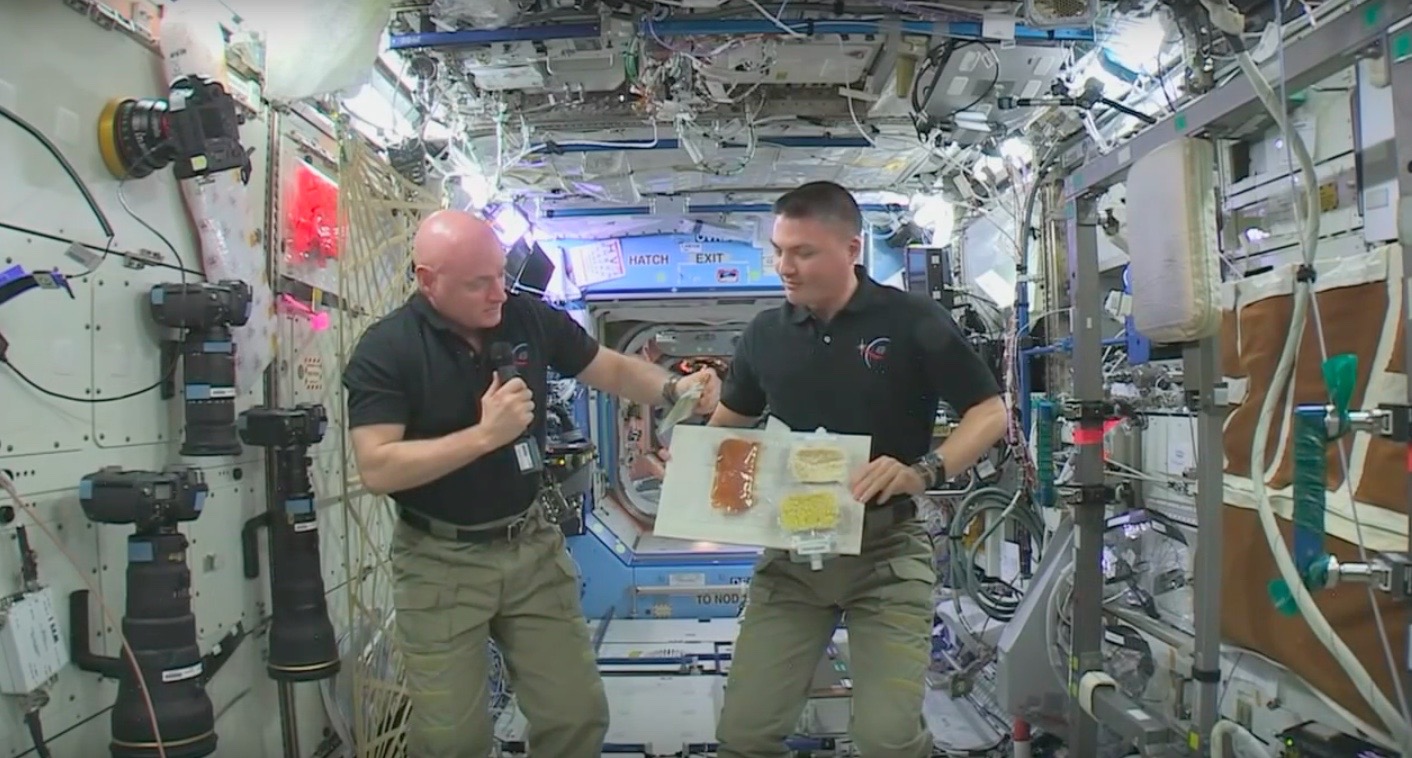


As people on Earth prepared to celebrate Thanksgiving, astronauts aboard the International Space Station marked the holiday in a unique way. The team of astronauts, including American, Japanese, and Russian crew members, shared their favorite dishes and traditions, while floating 250 miles above the Earth. The special Thanksgiving celebration in space showcased the international collaboration and spirit of unity among the crew members.
As people on Earth prepared to celebrate Thanksgiving, astronauts aboard the International Space Station marked the holiday in a unique way. The team of astronauts, including American, Japanese, and Russian crew members, shared their favorite dishes and traditions, while floating 250 miles above the Earth.
The special Thanksgiving celebration in space showcased the international collaboration and spirit of unity among the crew members. It also highlighted the challenges and triumphs of living and working in space.
Thanksgiving is a holiday that is celebrated in the United States, Canada, and other countries. It is a time to give thanks for the harvest and to spend time with family and friends.
The first Thanksgiving was celebrated in 1621 by the Pilgrims and the Wampanoag Indians. The Pilgrims were a group of English settlers who had come to America in search of religious freedom. The Wampanoag Indians were a Native American tribe who lived in the area that is now Massachusetts.
Thanksgiving dinner is typically a large meal that includes turkey, stuffing, mashed potatoes, cranberry sauce, and pumpkin pie. In space, the astronauts had to make do with freeze-dried food and other non-perishable items.
Each of the astronauts on the International Space Station shared their favorite Thanksgiving traditions.
Celebrating Thanksgiving in space is not without its challenges. The astronauts have to deal with the following:
Despite the challenges, the astronauts on the International Space Station have found ways to celebrate Thanksgiving in a meaningful way. They have shared their favorite dishes and traditions, and they have spent time together giving thanks for their many blessings.
The astronauts' Thanksgiving celebration is a reminder of the human spirit's ability to overcome challenges and find joy in even the most difficult circumstances. It is also a reminder of the importance of international collaboration and cooperation.
1. What is the International Space Station?
The International Space Station is a space station that is in orbit around the Earth. It is a joint project of five space agencies: NASA (United States), Roscosmos (Russia), JAXA (Japan), ESA (Europe), and CSA (Canada).
2. How long have astronauts been living on the International Space Station?
Astronauts have been living on the International Space Station since 2000.
3. What is the purpose of the International Space Station?
The International Space Station is used for a variety of research and educational purposes. Astronauts on the ISS conduct experiments in fields such as biology, chemistry, and physics. They also study the effects of microgravity on the human body.
4. How many astronauts are currently on the International Space Station?
There are currently three astronauts on the International Space Station: Christina Koch (USA), Anatoly Ivanishin (Russia), and Soichi Noguchi (Japan).
5. What is Thanksgiving?
Thanksgiving is a holiday that is celebrated in the United States, Canada, and other countries. It is a time to give thanks for the harvest and to spend time with family and friends.

In an effort to fight the ongoing air pollution crisis, Delhi conducted its first-ever official cloud seeding operation led by IIT Kanpur. The operation involved a small aircraft dispersing specially designed chemical flares into the atmosphere to create rain. While experts say rainfall could occur within 15 minutes to 4 hours, the actual timeframe depends on various factors such as wind direction and moisture content. If successful, the government plans to continue the operation in the coming days.

In the quest for stronger, luscious hair, we often overlook the importance of nurturing the roots. Fortunately, Ayurveda has long stressed the significance of this practice, which has now been backed by modern science. Studies have shown that herbs like Bhringraj and Amla can activate hair follicles, promoting new growth and delaying greying. Fenugreek, Neem, Hibiscus, and Ashwagandha are also found to be beneficial in strengthening and nourishing the scalp, resulting in thicker and healthier hair.

A college student shares her personal journey of becoming a vegetarian, despite facing challenges and health concerns. She then delves into an ethics class she took, where the concept of marginal cases were discussed. Following an article by philosophy professor Alastair Norcross, she concludes that even though individual action may seem insignificant, refusing to consume factory-farmed meat holds moral significance due to the potential to prevent immense suffering for animals.

On October 24, the global community commemorates World Polio Day to honor the legacy of Dr. Jonas Salk and the efforts of countless individuals and organizations in the fight against polio. This highly contagious and potentially deadly disease, once a widespread epidemic, is now largely preventable thanks to the development of a life-saving vaccine. India's successful eradication of polio serves as a testament to the importance of strong vaccination programs and collaborations in public health initiatives.

As winter arrives in India, so does the hazardous air pollution. Delhi NCR's AQI has already crossed the 400 mark, making it crucial to invest in air purifiers, especially after Diwali. Dyson, Qubo, HomePure, and Philips have launched high-quality air purifiers with advanced features to tackle different types of pollutants and create cleaner indoor air. With prices ranging from Rs 5,000 to Rs 1 lakh, these purifiers are a practical and timely purchase for a healthier living.

In a recent family vlog, Indian celebrity couple Shoaib Ibrahim and Dipika Kakar shared their "natural" hair care routine for their son, using a homemade mask made with rice flour, flax seeds, and coconut oil. However, experts warn that what works for adults may not be suitable for babies, whose sensitive skin and scalp could react to the ingredients. While the ingredients may improve hair texture, they do not necessarily promote hair growth. Instead, a healthy diet and good scalp care are more important in maintaining healthy hair.

A recent consumer study has found multiple brands of soft contact lenses in the U.S. to contain "forever chemicals" that can be harmful to both the body and the environment. The study, conducted by the nonprofit organization Environmental Health Sciences, tested 18 varieties of popular contact lenses and found all of them to contain markers for PFAS. Brands such as Acuvue, Alcon, and CooperVision were among the list of affected products. This news serves as a cautionary lesson on the potential risks of overusing contact lenses.

On the birth anniversary of Dr. APJ Abdul Kalam, the ‘Missile Man’ of India, tributes pour in on social media celebrating his life, vision and impact. A visionary scientist, inspiring leader and true patriot, Dr. Kalam's humility, compassion and constant interaction with students continue to inspire generations. His tireless efforts in defense, science and youth empowerment have strengthened India's path towards self-reliance and his legacy continues to motivate young minds to dream big and work hard for the nation.

Recent studies have found that extreme heat, particularly when combined with high humidity, can have a significant impact on mental health. A study in India showed that when wet bulb temperature exceeded 27°C, the probability of reporting severe depression increased by 0.5%, even when the temperature was slightly lower. This finding is consistent with global reviews that have linked high temperatures to mood disorders, increased hospital admissions for psychiatric conditions, and even elevated suicide risk. The Lancet has also published evidence that rising temperatures worldwide are a growing threat to emotional and cognitive health.

In a meeting with university officials in Udaipur, Rajasthan Governor Hari Bhau Bagde stressed the importance of incorporating India's ancient knowledge traditions into academic research. He highlighted the deep repository of knowledge in India since ancient times and urged scholars and scientists to draw upon this tradition in their work. Bagde also suggested making ancient texts available in university libraries for study and research purposes, in order to shape the intellectual abilities and love for the nation among the younger generation.